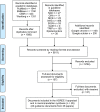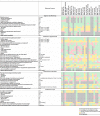Diagnosis and treatment for hyperuricemia and gout: a systematic review of clinical practice guidelines and consensus statements
- PMID: 31446403
- PMCID: PMC6720466
- DOI: 10.1136/bmjopen-2018-026677
Diagnosis and treatment for hyperuricemia and gout: a systematic review of clinical practice guidelines and consensus statements
Abstract
Objectives: Despite the publication of hundreds of trials on gout and hyperuricemia, management of these conditions remains suboptimal. We aimed to assess the quality and consistency of guidance documents for gout and hyperuricemia.
Design: Systematic review and quality assessment using the appraisal of guidelines for research and evaluation (AGREE) II methodology.
Data sources: PubMed and EMBASE (27 October 2016), two Chinese academic databases, eight guideline databases, and Google and Google scholar (July 2017).
Eligibility criteria: We included the latest version of international and national/regional clinical practice guidelines and consensus statements for diagnosis and/or treatment of hyperuricemia and gout, published in English or Chinese.
Data extraction and synthesis: Two reviewers independently screened searched items and extracted data. Four reviewers independently scored documents using AGREE II. Recommendations from all documents were tabulated and visualised in a coloured grid.
Results: Twenty-four guidance documents (16 clinical practice guidelines and 8 consensus statements) published between 2003 and 2017 were included. Included documents performed well in the domains of scope and purpose (median 85.4%, range 66.7%-100.0%) and clarity of presentation (median 79.2%, range 48.6%-98.6%), but unsatisfactory in applicability (median 10.9%, range 0.0%-66.7%) and editorial independence (median 28.1%, range 0.0%-83.3%). The 2017 British Society of Rheumatology guideline received the highest scores. Recommendations were concordant on the target serum uric acid level for long-term control, on some indications for urate-lowering therapy (ULT), and on the first-line drugs for ULT and for acute attack. Substantially inconsistent recommendations were provided for many items, especially for the timing of initiation of ULT and for treatment for asymptomatic hyperuricemia.
Conclusions: Methodological quality needs improvement in guidance documents on gout and hyperuricemia. Evidence for certain clinical questions is lacking, despite numerous trials in this field. Promoting standard guidance development methods and synthesising high-quality clinical evidence are potential approaches to reduce recommendation inconsistencies.
Prospero registration number: CRD42016046104.
Keywords: clinical practice guideline; gout; hyperuricemia; systematic review.
© Author(s) (or their employer(s)) 2019. Re-use permitted under CC BY-NC. No commercial re-use. See rights and permissions. Published by BMJ.
Conflict of interest statement
Competing interests: None declared.
Figures



References
-
- Smith E. March L: Global prevalence of hyperuricemia: a systematic review of population-based epidemiological studies. Arthritis & Rheumatology 2015;67:2690–2.
Publication types
MeSH terms
Substances
Grants and funding
LinkOut - more resources
Full Text Sources
Medical
